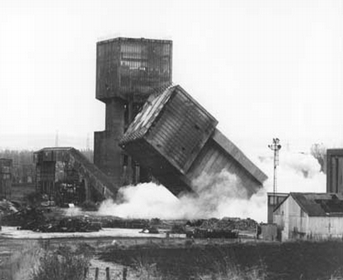The Story of Scottish Coal
Demolition of Scotland's last superpit, Monktonhall, near Edinburgh, destroyed with high explosives in 1977.
© Campbell Drysdale, SC445876
© Campbell Drysdale, SC445876
Monktonhall Colliery, near Edinburgh, was the last of Scotland's new superpits to be completed, and commenced production in 1967. At its peak in 1971, it employed over 1,700 miners, and produced coal for the local electricity generating station at Cockenzie.
In the 1990s, as the British coal industry was being privatised, Monktonhall was bought by a miners' co-operative, who hoped to keep it in operation, and to share the profits. Unfortunately, the huge scale of the mine, and the fact that its two 930 metre shafts required continuous pumping to keep them clear of water, resulted in the costs of production being too high. The miners did not have enough capital to sustain sufficiently high production, and the mine eventually failed.
At this time, demand for coal was dropping rapidly. It was illegal to burn it in towns and cities because of air pollution problems, and was no longer used by the railways. Coal gas had been replaced by natural gas from the North Sea, and many energy users used oil as a fuel. The British government had also reduced its dependence on coal by investing heavily in nuclear energy.
Despite attempts to preserve Monktonhall Colliery as an industrial monument to the coal industry, it was demolished in 1997.
In the 1990s, as the British coal industry was being privatised, Monktonhall was bought by a miners' co-operative, who hoped to keep it in operation, and to share the profits. Unfortunately, the huge scale of the mine, and the fact that its two 930 metre shafts required continuous pumping to keep them clear of water, resulted in the costs of production being too high. The miners did not have enough capital to sustain sufficiently high production, and the mine eventually failed.
At this time, demand for coal was dropping rapidly. It was illegal to burn it in towns and cities because of air pollution problems, and was no longer used by the railways. Coal gas had been replaced by natural gas from the North Sea, and many energy users used oil as a fuel. The British government had also reduced its dependence on coal by investing heavily in nuclear energy.
Despite attempts to preserve Monktonhall Colliery as an industrial monument to the coal industry, it was demolished in 1997.


